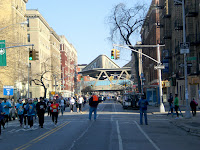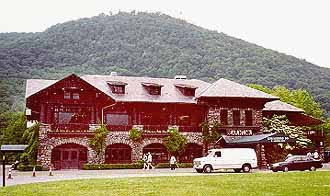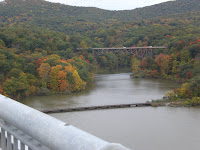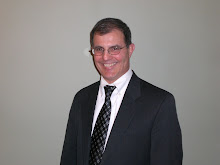Rockland Alumni Cross Country RunNovember 28, 2009
by: Jamie Kempton
North Grabs Record 9th Men’s Title, Albertus Women Capture 1st
Littmann-Viscardo earns record 8th crown; Nyack’s Rodriguez gets his first
Clarkstown North annexed its record-setting ninth men’s team title and Albertus Magnus captured its first women’s crown at the 27th annual Bill Markiewicz Memorial Rockland Alumni Cross Country Run at Bear Mountain on Nov. 28.
The race, co-sponsored by the Rockland Road Runners, is one of the oldest running events in Rockland County. Fierce, whipping winds buffeted the harriers and hindered performances, but 201 entrants managed to complete the 3-mile layout, which is marked by the steep ski-slope hill halfway through the run.
The Clarkstown North and Monroe-Woodbury men were tied through the regulation five scorers, 82-82. Using the sixth runner as a tiebreaker, the Rams emerged victorious to gain their ninth championship. North previously had shared the record of eight men’s titles with Albertus.
The Falcon women scored 92 points to lay claim to their first championship. They were led by eighth-place finisher Jo Ann Hodges, class of 1985, and 14th-placer Laurel Gilhooly Reilly, class of 1981, who was the Rockland County champion in 1980.
Bert-Justin Rodriguez, Nyack class of 1997, reached the winner’s circle after coming close the past three years. Rodriguez took the lead in the first mile and never relinquished it en route to a winning time of 15 minutes 44.5 seconds. Rodriguez was runner-up in 2007 and finished third in 2006 and last year. Niko Viglione, Somers class of 2005, finished 60 yards behind Rodriguez in 15:57.
Julianne Littmann-Viscardo, Monroe-Woodbury class of 1995, collected her eighth Alumni Run title, more than anyone – male or female – in race history. She had been tied with Art Gunther, Tappan Zee class of 1989, for most individual championships at seven. Littmann-Viscardo, a former Clemson University standout, ran 20:22 for a decisive win over runner-up Suzanne LaBurt, Monroe-Woodbury class of 1981, who clocked 20:48.
Albertus Magnus took the team participation title with 48 finishers, the fourth-highest total in meet history. The former Falcons were mobilized by the efforts of Kevin Russo, class of 1974, one of the original 21 participants in the inaugural Alumni Run in 1983, and John McNiff, class of 1975, president of the school’s track booster organization, the Falcon Spiked Shoe Club.
Overall, 48 high schools from nine states were represented, including schools in California, Wisconsin, North Dakota, Minnesota and Virginia. This year’s race also welcomed international participants from Ireland and Canada. The oldest finisher was Bernie Casserly of New City, 68, a 1959 graduate of Erasmus Hall High School in Brooklyn.
The race is named in honor of Bill Markiewicz, a 1967 Albertus graduate who spent 11 successful years (1978-89) as Clarkstown North’s head cross country and assistant track coach, and was one of Rockland cross country’s most enthusiastic proponents. When he died of cancer in March 1991, the race was renamed in his memory and an award was initiated to recognize an individual who has made a lasting contribution and rendered distinguished service to Rockland cross country.
This year’s Markiewicz Award winner is Ray Sussmann, Pearl River class of 1981, the longtime coach of the Clarkstown/Felix Festa Middle School’s seventh- and eighth-grade cross country teams and the jumps coach for the Clarkstown South track team. Sussman was the senior captain of Pearl River’s 1980 state championship cross country team and has participated in 19 straight editions of the Alumni Run.
Two former Albertus Magnus harriers kept alive their streak of never having missed an Alumni Run: Pat Chambers, class of 1976, the race’s inaugural champion in 1983; and Larry Beckerle, class of 1973, who coached the 1990 Nanuet girls’ cross country team to the state Class C title.
27th annual Bill Markiewicz Memorial Rockland Alumni Cross Country Run
Saturday, November 28, 2009
Bear Mountain State Park, Bear Mountain, N.Y.
Course: 3.0 miles
Meet records: 14:08, John Trautmann (Monroe-Woodbury ’86), 1994
17:03, Debbie Grant (Ramapo ’83), 1995
Men’s Team Scores: 1. Clarkstown North (CN) 82 (wins on sixth-runner tiebreaker); 2. Monroe-Woodbury (MW), 82; 3. Suffern (Suf), 108; 4. Albertus Magnus (AM), 147; 5. Pearl River (PR), 229; 6. North Rockland (NR), 294; 7. Nanuet (Nan), 346; 8. Tappan Zee (TZ), 424; other teams incomplete.
Women’s Team Scores: 1. Albertus Magnus (AM), 92; other teams incomplete.
Team Participation (Combined): 1. Albertus Magnus, 48; 2. Suffern, 22; 3. Monroe-Woodbury, 21; 4. Clarkstown North, 14; 5. Pearl River, 12; 6. Tie, Nanuet and North Rockland, 9; 8. Tie, Clarkstown South (CS) and Tappan Zee, 6; 10. Spring Valley (SV), 4; 11. Tie, Arlington (Arl), Goshen (Gosh), Millbrook (Mill), Newburgh Free Academy (NFA), 3; 15. Tie, Beacon, C.D. Hylton (Woodbridge, Va.), Nyack (Ny), Somers (So), 2; 18. Tie, Achill (Ireland), Bayside, Bronx H.S. of Science, Burke Catholic, Chaminade, Don Bosco Prep, Dwight-Englewood (N.J.), Erasmus Hall, Fairfield (Conn.), Fargo North (N.D.), Farmington (Conn.), Hendrick Hudson, Hilton, Jesuit, Mahwah, Mepham, Middletown, New Rochelle, Notre Dame College (Welland, Ontario, Canada), Peekskill, Prescott (Wis.), Ramapo, Rosary Academy, Shasta (Redding, Calif.), St. Cloud Apollo (Minn.), St. Gabriel, South Kent (Conn.), Waldwick (N.J.), Westerly (R.I.), Woodside (Calif.), 1.
Women’s Top 20 Individuals (46 women finishers)
1. Julianne Littmann-Viscardo (MW ’95), 20:22; 2. Suzanne LaBurt (MW ’81), 20:48; 3. Dayna McLaughlin (NR ’08), 21:54; 4. Katie Ansorge (Arl ’01), 23:05; 5. Tiffanee Hager (Fargo North, N.D. ’97), 23:10; 6. Leslie Ballantyne (Suf ’92), 23:10; 7. Melissa Ponzio (So ’00), 23:55; 8. Jo Ann Hodges (AM ’85), 24:16; 9. Eileen Naylor (MW ’94), 25:00;
10.
Jill Pietropaolo (CS ’06), 25:07; 11. Erica Norey (CN ’00), 25:08; 12. Gail Trautmann (Hilton ’95), 25:21; 13. Liz Rhein (Rosary Academy ’75), 25:24; 14. Laurel Gilhooly Reilly (AM ’81), 25:34; 15. Aime Goldberg (Nan ’94), 25:48; 16. Teresa Kenny (CN ’83), 26:01; 17. Amanda McLaughlin (NR ’04), 26:05; 18. Jeanne Teetsel (AM ’81), 26:38; 19. Patti Zodda (Nan ’88), 28:08; 20. Teresa Scott (CS ’80), 28:42.
Overall Individual Results
1. Bert Rodriguez (Ny ’97), 15:44.5; 2. Niko Viglione (So ’05), 15:57; 3. Kyle O’Brien (MW ’06), 16:03; 4. Paul Lagno (Mill ’08), 16:21; 5. Dylan Kurten (Mill ’09), 16:54; 6. Armando Oliveira (New Rochelle ’85), 17:04; 7. Scott Dickover (Middletown ’06), 17:10; 8. Einar Gary Brissing (Nan ’01), 17:14; 9. Brian Crowley (AM ’82), 17:24; 10. Tom Zarnoch (MW ’08), 17:29; 11. Tom Dillon (CN ’97), 18:00; 12. Michael Koral (Suf ’07), 18:02; 13. unidentified entrant, 18:05; 14. Jason Friedman (CN ’93), 18:12; 15. Mike Pereira (Suf ’09), 18:17; 16. Jamie Kempton (AM ’76), 18:19; 17. Ed Ackerly (MW ’86), 18:21; 18. Mike Morris (CN ’96), 18:27; 19. Pat Driscoll (CN ’98), 18:43; 20. Tom McCarney (CN ’93), 18:49; 21. Andy Kohlbrenner (PR ’81), 18:58; 22. Jamsel Reyes (NR ’01), 19:00; 23. David Blumel (MW ’75), 19:09; 24. Rich Barbera (Suf ’09), 19:31; 25. Matt McKenna (CN ’03), 19:32; 26. Dominick Ponzio (NR ’00), 19:37; 27. Jim Trautmann (MW ’90), 19:54; 28. James Attle (Suf ’98), 19:57; 29. Zack Berbit (Suf ’96), 20:16; 30. Julianne Littmann-Viscardo (MW ’95), 20:22; 31. Tom List (PR ’80), 20:23; 32. Anthony Modafferi (CS ’04), 20:25; 33. Paul Mueller (St. Cloud Apollo, Minn. ’02), 20:30; 34. Alex Berbit (Suf ’99), 20:39; 35. Alfredo Godinez (CN ’08), 20:47; 36. Suzanne LaBurt (MW ’81), 20:48; 37. Patrick Markiewicz (Burke Catholic ’06), 20:49; 38. Kevin Leonard (AM ’76), 20:52; 39. John MacKenzie (TZ ’98), 20:55; 40. Rafael Ortiz (SV ’05), 20:57; 41. Fernando Godinez (TZ ’96), 21:02; 42. Mike Colangelo (AM ’75), 21:06; 43. Chuck Sommerlad (MW ’85), 21:14; 44. George Rhein (Don Bosco ’73), 21:18; 45. Chris Hecht (CN ’01), 21:25; 46. Bob Hermesch (Hen Hud ’68), 21:29; 47. Steven Estremera (Mill ’08), 21:34; 48. John Fenn (AM ’79), 21:36; 49. Tim Hodges (AM ’80), 21:38; 50. Matt Markiewicz (Gosh ’93), 21:43.
51. Brian Kelly (AM ’75), 21:45; 52. Tim Waples (Suf ’00), 21:50; 53. Jerry Quigley (SV ’75), 21:51; 54. Bernard Patten (Achill, Ireland, ’67), 21:53; 55. Dayna McLaughlin (NR ’08), 21:54; 56. Chris O’Brien (MW ’04), 21:55; 57. Mike Bromm (Nan ’78), 21:55; 58. Jim Dugandzic (PR ’81), 22:00; 59. Mike Ward (PR ’81), 22:01; 60. Randall Duggan (Shasta, Redding, Calif. ’88), 22:34; 61. Ian Diamond (Nan ’91), 22:41; 62. David Herbstman (Ramapo ’79), 22:43; 63. Robert Johnston (Suf ’68), 22:44; 64. Matt Diglio (MW ’96), 22:47; 65. Kevin Chanowsky (MW ’94), 22:51; 66. Joel Outten (Fairfield ’98), 22:56; 67. Katie Ansorge (Arl ’01), 23:05; 68. Michael Sciarrillo (Ny ’95), 23:05; 69. Pete Viscardo (MW ’95), 23:06; 70. Chris Craig (AM ’82), 23:06; 71. Tiffanee Hager (Fargo North, N.D. ’97), 23:10; 72. Leslie Ballantyne (Suf ’92), 23:10; 73. Jim Sussmann (PR ’83), 23:14; 74. Ray Sussmann (PR ’81), 23:17; 75. Danny Cruz (NR ’97), 23:20; 76. Ed Hushon (AM ’83), 23:22; 77. Evan Ratnow (Suf ’96), 23:26; 78. Steve Beckerle (AM ’74), 23:35; 79. North Rockland ’94, 23:36; 80. Mike Moran (AM ’83), 23:39; 81. Ed Howard (Mahwah ’72), 23:45; 82. James Whalen (So. Kent, Conn. ‘ 07), 23:48; 83. Dan O’Brien (AM ’77), 23:49; 84. Larry Beckerle (AM ’73), 23:50; 85. Mike Weiss (Suf ’96), 23:51; 86. Edward Meyer (Jesuit ’96), 23:53; 87. Melissa Ponzio (So ’00), 23:55; 88. Keith Reilly (PR ’90), 23:56; 89. Matt Ammer (Suf ’94), 23:57; 90. Ed Casey (PR ’82), 23:59; 91. Josh Levine (Suf ’96), 24:01; 92. Harry Owens (Chaminade ’76), 24:03; 93. Dan Avener (Suf ’65), 24:04; 94. Mark Nedell (Suf ’96), 24:07; 95. Brendan O’Brien (CN ’04), 24:10; 96. Jo Ann Hodges (AM ’85), 24:16; 97. TJ Maglione (MW ’01), 24:34; 98. John McNiff (AM ’75), 24:42; 99. Pat Parietti (Suf ’78), 24:49; 100. Eileen Naylor (MW ’94), 25:00.
101. Adam Borg (CN ’97), 25:02; 102. Jill Pietropaolo (CS ’06), 25:07; 103. Erica Norey (CN ’00), 25:08; 104. Ross Stephens (Arl ’94), 25:17; 105. Chris Ingrassia (AM ’71), 25:18; 106. Tom Maloney (AM ’72), 25:20; 107. Gail Trautmann (Hilton ’95), 25:21; 108. Liz Rhein (Rosary Academy ’75), 25:24; 109. Alan Brandstaedter (CN ’92), 25:26; 110. Mark Hughes (Woodside, Calif. ’70), 25:29; 111. Ben Walker (Notre Dame College, Welland, Ontario, Canada ’85), 25:30; 112. Laurel Gilhooly Reilly (AM ’81), 25:34; 113. Aime Goldberg (Nan ’94), 25:48; 114. Bob Eckerle (TZ ’78), 25:59; 115. Teresa Kenny (CN ’83), 26:01; 116. John Herr (MW ’83), 26:02; 117. Jered Haag (MW ’89), 26:03; 118. Amanda McLaughlin (NR ’04), 26:05; 119. Jim Martin (Peekskill ’65), 26:13; 120. Ralph Cosenza (Suf ’77), 26:26; 121. Jose Reyes (NR ’85), 26:27; 122. Kevin DeSantis (Gosh ’95), 26:35; 123. Jeanne Teetsel (AM ’81), 26:38; 124. Nick Parente (CN ’87), 26:41; 125. Colin Gribbin (NFA ’89), 27:19; 126. Jeff Ratnow (Suf ’89), 27:25; 127. Mike Collins (Mepham ’78), 27:50; 128. Patti Zodda (Nan ’88), 28:08; 129. Bernie Casserly (Erasmus Hall ’59), 28:13; 130. Ken Kinsley (Nan ’81), 28:15; 131. Terry Moore (AM ’77), 28:19; 132. Buddy Gilbert (Beacon ’75), 28:35; 133. Teresa Scott (CS ’80), 28:42; 134. Mike McNamara (AM ’80), 28:48; 135. Rob McNamara (Nan ’86), 28:49; 136. Christine Dolan (MW ’94), 28:51; 137. Jerome Kane (AM ’78), 29:01; 138. Robert Egic (TZ ’68), 29:14; 139. Agnes Brenson (Dwight-Englewood, N.J. ’98), 29:23; 140. Jennifer Gribbin (NFA ’92), 29:29; 141. Pat Chambers (AM ’76), 29:33; 142. Jay Kaplan (SV ’67), 29:38; 143. Aaron Krochmal (CS ’92), 29:41; 144. Mike Greco (PR ’78), 29:42; 145. Tom Kelly (PR ’78), 29:53; 146. Jennifer Markiewicz Wagman (Gosh ’92), 29:59; 147. Mary Vota (AM ’89), 30:13; 148. Kathy List (PR ’91), 30:23; 149. Joanie (Kiggins) Greenwood (AM ’85), 30:29; 150. Bob DeMarco (Beacon ’69), 30:34.
151. Rebecca Ratnow (Suf ’94), 30:45; 152. Mark Markiewicz (C.D. Hylton, Woodbridge, Va. ’95), 30:49; 153. Catherine Dillon (Prescott, Wis. ’96), 31:02; 154. Linda Nedell (Westerly, R.I. ’96), 31:13;
155. Paul Pietropaolo (Nan ’76), 31:32; 156. Ken Gerber (CS ’92), 31:35; 157. J. Lee Snow (MW ’83), 31:38; 158. Gerald Conlon (MW ’84), 31:41; 159. Sue (Gulla) Lanoce (PR ’83), 31:43; 160. Kevin Monahan (MW ’85), 32:12; 161. Neil Coleman (AM ’72), 32:27; 162. Dan Hogan (Suf ’99), 32:35; 163. Jack Arbolino (TZ ’68), 32:35; 164. Steve Kondracki (TZ ’68), 32:48; 165. Chris Markiewicz (C.D. Hylton, Woodbridge, Va. ’95), 33:09; 166. Eric Brandon (Bronx H.S. of Science ’86), 33:20; 167. Karen Brown (AM), 33:26; 168. Mary (Brechbiel) Agnetti (AM ’74), 33:30; 169. Heather Traina-Cruz (NR ’98), 33:36; 170. Mike Markiewicz (AM ’70), 33:42; 171. Maureen Teetsel Hunter (AM ’78), 33:43;
172. Janet Pietropaolo (Nan ’80), 33:54; 173. Peter Markiewicz (CS ’75), 34:13; 174. Lisa Ratnow (Arl ’96), 34:14; 175. Lisa Dietrich (Suf ’94), 34:16; 176. John Leonard (AM ’74), 34:28; 177. Lou Slattery (AM ’77), 34:50; 178. Bonnie Koop (Haverstraw ’66), 34:59; 179. Howie McNiff (AM ’73), 35:21; 180. Sal Viscardo (MW ’91), 35:52; 181. George Hoy (SV ’69), 36:40; 182. Jennifer Sherman (Suf ’96), 36:41; 183. Jeff Sherman (Waldwick, N.J. ’97), 36:42; 184. Vicki Bibbo (St. Gabriel ’73), 37:34; 185. Jonathan Macdonald (Farmington, Conn. ’93), 37:57; 186. Janet McNamara Barron (AM ’79), 38:05; 187. Chip Moreau (AM ’74), 38:07; 188. Kevin Russo (AM ’74), 38:10; 189. Rick Teetsel (AM ’79), 39:52; 190. Frank Cotter (AM ’76), 40:15; 191. Warren Berbit (Bayside ’60), 40:19; 192. Colleen Quinn (AM ’74), 45:44; 193. Brian Beckerle (AM ’08), 45:46; 194. Bill Brown (AM ’77), 46:34; 195. Mike Teetsel (AM ’77), 46:40; 196. Joe Gibaldi (AM ’77), 46:41; 197. Cathy Gibaldi (AM ’83), 46:41; 198. Neil Galeota (AM ’77), 46:42; 199. Madeline Mulligan (AM ’77), 46:43; 200. Matt Mulligan (AM ’75), 46:44; 201. Janet Jasinski Swinnich (AM ’77), 46:45.




























































